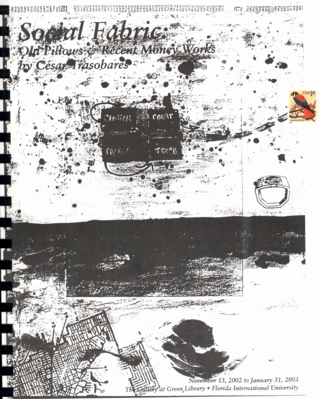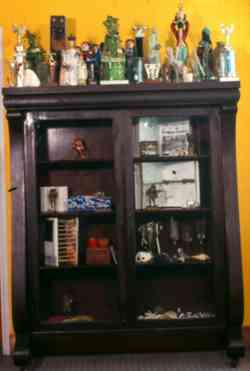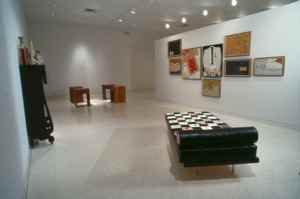>>SELECTED CATALOGUE TEXTS<<
"[I]f these pillows from the early and mid-90s merrily partake of one kind of American folk tradition—giving it, as we used to say, a good old country goose—Trasobares's recent work, money sculptures as perky as chia pets though considerably more dangerous-looking, makes rowdy use of another. The money pieces are based on the prevalent habit people have of marking dollar bills, as a dog would mark a doorway, and passing them along. This popular vandalism actually has countless strands and permutations: dollar bills as chain letters, as handbills for sloganeering, as pickup notes and suicide notes; as a canvas for painting and a page for diary entries, poetry and sentiments both lofty and flea-bitten.
"Just as language is the currency of official ideology, money talks, and
Trasobares avails himself of its fluency. His collection of altered bills is
impressive,
and he has made numerous doodlings, paint jobs and origami himself. He also
wrote a chronology of his love affair with money that begins in Cuba when he
is eight years old and stashing silver dollars in a cigar box, dreaming of
life in the USA.
“Over the years he has undertaken many small money projects, but it is
in his profligate shredding of money and reassembling the scraps into sculptures
that
Trasobares waxes most subversive. Money is capitalism's bricks and girders,
its blood and sinew, and, moreover, only the government is supposed to control
its circulation. Yet here he is, a government unto himself, taking the stuff
out of circulation when he pleases and then returning it, but in a currency
of his own choosing, that stuff of dubious value, art. It's breathtaking, like
hearing what's best left unsaid. And the works he fashions from the ravages
are as various and disquieting as those pillows, whose comforts are scant indeed.
There is a body of faux desert foliage in shot glasses, as spiky as medieval
maces or abundantly hairy like ciliaed sea life.
"He has a series of coral and money pieces which he calls SoBe Bonsai,
and numerous others: puppet men tatooed with pyramids and American eagles,
with penises
as anatomically correct as parchment will allow; a slithering cobra on a stick;
a bra fit for a doll-size Wagnerian opera.
“Such restless intelligence, so much arcane knowledge sopped up from
whatever life and learning's cast his way, and you have to factor in temperament,
the
forbearance of a bohemian dwelling many years among clods: the thing that would
cause a man to heap up chairs in the lobby of an art museum is that what he's
heaping up is words, spelling things out; and embellishing pillows like a nineteenth
century spinster gives a man time to think just how to really put what he's
been mulling over his whole life; and if you tear up enough dollar bills, you
can tell the Devil himself to go on back to Hell."
Introduction
by Joel Weinstein to catalogue of Social Fabric: Old Pillows
and Recent Money Works
The Gallery at Green Library, Florida International University, November
13, 2002 to January 31, 2003
“The showcase, as an
instrument of display and custody, as an enforcer of distance, plays a
principal role in the physical and cultural definition of art within the space
of the museum. Because display cases hold actual objects, unlike printed images
in books and pixelated apparitions on monitors, the viewer's connection with
the art object in a showcase is a multi-leveled, sensory encounter. As guardian
and agent of an ongoing historical process of viewing and reviewing, and as holders
of evidence for comparison, display cases allow the object to transcend its own
containment, even while maintaining a kind of custody and safety, quietly
locked behind glass...
“Like giant display
cabinets, museums both guard and distance—through antiseptic and generic
display strategies—the mystery of the objects they present. Increasingly,
however, museums are rethinking their institutional procedures and social
effects, and are inviting artists to engage with their spaces and collections
in ways that are not normally practiced by curators...
“As a cultural institution,
as a place where we expand our references, where we come into contact with
actual works of art, the modern museum is a virtual extension of the church,
the palace, the court, and the artist's own studio. Yet in today's art museums,
living artists are in the paradoxical position of being both outsiders and
insiders to these locked spaces. In the project Travels of the Artist
(References Inside) I will display my
artworks, personal objects, notes, and selected works from the museum
collection in a heterogeneous group of display cases. The installation will
create an environment in which selected objects from the museum's collection
are recontextualized... I aim to provide a framework for appreciating
individual objects—by opening up an unusually broad space of enjoyment and
feeling for the viewer—while allowing individual narratives to appear and
intersect, thus expanding the environment in which artworks are perceived. My
aim is to place certain art works in a new physical, cultural, and affective
framework, liberating the potential relationality of each artwork.
Art has the potential to
transform our perceptions; it moves us to look and feel in ways both personal
and universal. In encountering works of art, humanity's past and present and
individual realities can coalesce. My installation encourages the viewer to see
and perceive; it is an opportunity to feel that the museum can be anyone's
garden and battleground.”
Artist’s
page in catalog of Crossings and Departures: Making Art in Miami,
Allen
Memorial Art Museum, Oberlin College, 4 April to 11 May, 1997
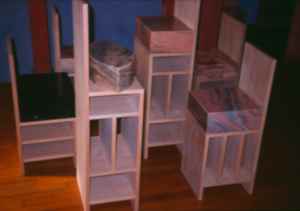
“… The
decrease in the scale of emotionality with which Trasobares looks at things
today is conspicuous, especially in light of his ‘Cuban’ works from twenty
years ago. In order to understand how radical his move is, how extreme is the
decision he made in striving towards the specific qualities, toward the zero
point of shapes and materials, one must go back to the raft motif, which had
been charged by him as a political symbol of exile, long before it became
commonplace as the ultimate overused icon of Cuban art. Moreover, one has to go
back to the series of works related to the QuinceaĖera — a Cuban initiation
ceremony for girls — which had been described by him through an
archaeological-anthropological approach, as a trenchant portrait of what he
calls a "dying social ritual". Indeed, the ironic-parodical-critical
approach which had characterized that series (related to social conventions of
sexual behavior) had by then already marked, in fact, the way out of the Cuban
ghetto. Yet, the formal language - the material, collagistic wealth, the
assemblagistic nature, the multiplicity of personal items, the boxes, the
purses, the ornaments, the drawers, the showcases, the flowers, the garments,
the sequins, the cheap jewels, the souvenirs, the 'grandmotherly' lace, the
gold, the velvet - all these had still been anchored in the earthly, pulpy,
soft element of life, and had composed a personal mosaic saturated with
childhood memories; a fantasy which had referred to memory mechanisms and to
the way in which nostalgia kills memory.
Long
before the Cuban discourse became attractive in the New York art market (with
all the cliches and expectations for "multi-cultural authenticity"
involved), Trasobares had already deconstructed the iconography of the exiled
culture. Towards the end of the eighties, when the authentic, multicultural
wave reached its peak, Trasobares had already been past that stage. He stopped
identifying himself as a "Cuban" artist and sought to evade any kind
of restricting ethnic demarcation. "Art is a universal language. Any
attempt to attribute it to a specific district only makes it problematic and
limited... I know what happens to an artist who becomes the 'representative of
his/her culture'... I no longer wish to carry around with me, wherever I go, my
cultural luggage and ethnic heritage; from now on, I carry around in my
suitcase only things I really need.”
In a preliminary
conversation we held, Trasobares used the image of "fever” when depicting
the period he was preoccupied with local themes. The process he has undergone
since then seems to him like a syndrome of healing. However, the process of
purification from the past, cleansing from ethnic elements, the shift from a
specific discussion of Cuban politics and a strategy of exile to a more general
discussion referring to the politics art world as an embodiment of power
mechanisms, and from there — the shift to the pure shape — all this doesn't
happen overnight. These are moves which have required a long line of decisions
concerning form and material, essentially involving reduction, cancellation,
relinquishment and avoidance. …”
Text by
Tami Katz-Freiman, “I AND THOU*: Processes of Abandonment and Anorexic
Purification in César Trasobares’ New Sculptures” Miami Art Paper, Ambrosino Gallery, March 1996
(catalog of Tryst
exhibition)
“,,, César Trasobares
creates order out of chaos by carefully compartamentalizing his life history
within a vitrine. Old Cuban postcards, personal notes and photographs, such
relics as one of Lydia Cabrera’s magic stones, and fragments of friend Carlos
Alfonzo’s ceramics reveal the artist and the man. …”
Curator
Giulio V. Blanc’s essay in
Latin American Art in Miami Collections
Lowe
Art Museum, Coral Gables, 1994
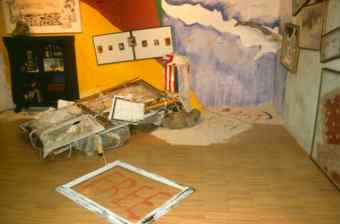
Living
outside South Florida during my college years, I returned to Miami in 1974 with
a keen adult interest in Cuban culture. I had painted Cuban subjects as a
student in Florida Universities: "Holguin Princess,“ "First Communion
Portrait," debutantes, "Putas de La Habana Vieja," pastelitos
(de carne, guayaba, queso …), among others. To entertain friends I would
impersonate Cuban characters, reciting like Luis Carbonell ("Los Quince de
Florita") and parodying the speech and writing of fictional Cuban
high-society ladies, Flema del Monte, ‘Boquita de Pescado’ among others.
Once,
defending "the ethnic subject" of the artworks during a class
critique, I had called them (all puns intended) a form of "Cubanistic Pop
Art." Asserting the characters and images of my cultural inheritance
through the "Cuban subject matter" in artwork became a means to
distance myself from "late-Modernist mainstream culture,' while exploring
alternative formats to the "painting-on-wall, sculpture-on-base Art
Academy modes,' arguing that the visual artist had marginated himself from
society, and "painted himself into an abstract no-man's land."
Finding
the Fiestas de Quince at their most lavish and elaborate stage in Miami
bolstered my energies and interest to evolve the QuinceaĖera Works. The Fiesta
is a formal, ball-like event hosted by the parents of the 15 year-old girl
making her "debut" in "society,“ involving singing, playing piano
or ballet dancing by the girl/woman to show her talents, formal dancing of
waltzes and Cuban historical songs, along with formal dresses and men's wear. I
thought the Quince revealed much about exile culture: its social structures,
aspirations, professions, taste, class struggles, even religion. The process of
the ceremony for the girl, the family, the guests, the professionals supporting
the lavish production and bountiful food lasted for months and its bills at
times required a second mortgage to the family home, all to "showcase good
taste and civilization."
As I
worked with Rosata Quinceanera, a private heroine who channeled personal
perceptions about the girl/woman and the ritual, my focus evolved from
portraying an image of exile prosperity and esthetic excess, through versions
of tracking cultural aspiration, to the chronicling of a dying modern ritual.
Eventually I came to see Rosata Q. as a possible early-life phase of Duchamp's
Bride, a cousin to Boucher's courtesan, a Minoan dancer, and, always, an insignificant
Petit Bourgeois having a ball, and, as all these, a part of a tradition of
portraiture and historical/mythological/social figurative art.
The
QuinceaĖera Works encompassed collages, sculptures, drawings and a group of
boxes/cases. The collages and sculptures included pieces of material and actual
dresses along with party napkins, decorations, favors and souvenirs. The
drawings were mostly about stage-sets and conceptual party themes, at times
including texts. The boxes contained improvised Quince party scenes, using
figures and props from the Fiestas.
In the
context of "status portraits" in the European salon painting
tradition, the Chaperonas had a relation to the Cuban women's custodianship of
culture, being the guardians of the stories and objects of each family. Each of
these works had a gilded frame and a pair of eyes as a reference to their role
and included actual dresses, objects and purses. Beyond the studio objects, I
also staged planned and impromptu performances and a video, "Iberia: I Want
to Be a Cake for My 15." I also produced a series of "Potentates,“
about the macho elements in Latino culture and a couple of "QuinceaĖera
Club Officers" dealing with the business aspects of the Quinces.
Later,
having started to pursue other territory, I would develop installations using
QuinceaĖera dresses, flags, boxes and Chaperonas. At this stage my interest in
the QuinceaĖera, beyond that of an exile archetype, or a reflection of
Colonialist culture residuals, was as an adolescent undergoing a rite of
passage among peers and elders. The "artwork" about her now had the
form of a display, including photos and actual memorabilia, somewhat like the
cases in anthropology museums of exotic and extinct cultures. By 1983 I knew I
had exorcised the QuinceaĖera in me. Certainly the "Holguin Princess"
of 1976 had come a long way.
Always
embodying personal longings and curiosities, Rosata QuinceaĖera, along with
other Cuban costumbrista characters, dragging along the insular baggage, are
flying the coop for a spin. This installation illustrates and diagrams their
take-off path, and mine.
Artist’s
statement in catalog of CUBA-USA: The First Generation, Fondo del Sol, 1991-1992.
“…
Memories of an idyllic childhood in Cuba, which came to an abrupt end when Fidel
Castro came into power, fuel Cesar Trasobares' imagination. Transformation from
childhood to adulthood, in particular, has been a continuous theme in his work.
His QuinceaĖera series of the 1970s and 1980s
explored the Latin American rite-of-passage celebration for fifteen-year-old
girls. The four photo collages from his El NiĖo Que Yo Fui (The Child I Was) chart
Trasobares' own transformation from a child in Cuba to an adult living in
Miami. In this work, Trasobares juxtaposes drawings and text with laser prints
of photographs marking important moments in this transformation. Trasobares
uses the drawings and text to try to reclaim his thoughts at the time the
photographs were taken. The photograph of six-year-old Trasobares at his First
Communion is superimposed on a self-portrait by the adult artist who is forced
to confront his childhood dreams. The second photograph was taken when he was
nine, an age when he was expected to take on adult responsibilities and become
familiar with his " family's properties and farms in Cuba. The next is a
passport photograph taken when he and his family were living in exile in
Mexico. This was a puzzling time during which the family pondered its options
before moving to Miami. The final a work in progress picturing Trasobares fully
grown, was taken around the time he decided to register in the architecture
program at college. The effect of the photocollages is cumulative: time, events
and twists of fate contribute to a portrait of the artist as a young man. ...”
Curator
Bonnie Clearwater’s essay in Arrested Childhood, Center of Contemporary Art, 19
May to 2 July, 1994
“…
Cesar Trasobares dreams the dreams of an exile. After moving with his family to
Miami from Cuba at the age of 15, his imagination was fanned by his memories of
the magical land of his childhood. In his recent works, Trasobares uses curio
cabinets and vitrines as metaphors for his psyche. In these he gathers
selections of his works from the 1970s to the present including examples from
his "QuinceaĖera" series (works exploring
the Latin American celebration for 15-year-old girls), his archive of rings
(consisting of over 4,000 catalogued and categorized specimens), artist books
and works in which he maps out the terrain of the "art world." In his
recent pillow works, Trasobares continues his exploration of alternative art
forms. As with his rings, the pillows are small-scale sculptures created in a
medium associated with handicraft. Trasobares, however, subverts the sweet
sentiments that are often stitched or appliqued on pillows by transforming his
cushions into potent objects that transport ideas right into people's living
rooms. …”
Curator
Bonnie Clearwater’s essay in Southern Roots: South Florida Invitational at the Museum of Art, Ft.
Lauderdale, 1993
“My
aesthetic interests are an extension of my childhood. I remember my
grandmother's concern with having furniture restored; I in charge of birthday
parties and the creche at Christmas; the time spent with my aunt Gloria, who
was an artist. We stayed in Oriente province throughout the revolutionary
struggle, but, within two years of Castro's ascent to power, things
deteriorated. The government confiscated our house and other properties. My
mother sold her jewelry to afford our expenses of leaving the country. We lost
everything, except the joy of living. The first years in exile we had no money;
we had no regrets, either. I started architecture in Miami to please my
parents, but I could not take the rigid curriculum. I obtained my degree in art
history; when I returned to Miami, I became concerned about Cuban culture. Our
insistence on stereotypes annoyed me; I started to research Cuban "Sweet
Fifteen" party rituals and the chaperone tradition. For me, there is a
clear connection between the baptismal gown, the first communion dress, the
fifteenth birthday gown, the wedding gown and the shroud over the coffin. Maybe
our culture survives through these rituals, through a pretentious social
climbing common among many Cubans. While preparing the retrospective exhibition
of Cuban modernist Enrique Riveron, I learned what the life of an exile artist
is like. I also realized that the key to survival lies in reflecting the
autochthonous elements of one's culture. The "Sweet Fifteen" rituals
are genuinely Cuban. There is a little bit of magic, of superstition, of
irreverence in us; a peculiar attitude for which I have no explanation.”
Statement
from interview with artist in catalog of exhibition
Outside
Cuba,
Contemporary Cuban Visual Artists, 1989
Cesar
Ernesto Trasobares has made the exploration of Cuban-American popular culture
the subject of his art. Born in Holguin, Cuba in 1949, he came to Miami with
his family when he was sixteen. Thus he had already participated in QuinceaĖera, the lavish Hispanic rite of
passage for fifteen year old girls, still enjoyed in Cuba, Miami, and
elsewhere. He designed his first QuinceaĖera stage set for his senior high school class, By the
time he had completed his graduate studies in art in 1974 he had embarked on
the conceptual transformation of his own living heritage into varied media
including performance, environmental boxes, drawing, video, and costume. Until
1984 he made Cuban rituals, and the nostalgia and pageantry surrounding them,
the principal themes of his art. Trasobares is presently director for Art in
Public Places for Dade County. De donde son los cantantes (1979 - 83), the Cuban song
actually heard in this three-part multimedia piece, was popular in the United
States in this recording, It evokes the romantic view of pre-Castro Cuba which
since Prohibition had been a glamorous haven for Americans to drink, gamble,
dance, and party. Trasobares built this elaborate, outlandish, kitschy diorama
into the three drawers of a thrift-shop dresser, By using furniture, fabric
draped to resemble the Havana area of the island, oyster shells, religious
medals, crucifixes, tacky dime-store chains-all real objects, rather than
representations-Trasobares alludes to the belief that in mementoes of
experience, one can postpone the passage of time.
Text by
Guest Curator Cynthia Jaffee McCabe
The American Experience: Contemporary
Immigrant Artists
The
Balch Institute for Ethnic Studies, 1986
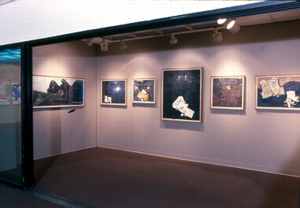
The
formal complexity of César Trasobares’ series, Las Chaperonas, precludes
anyone’s looking at these works as mere ethnic or social commentary. While it
is true that these pieces make witty assaults on the outmoded conventions of
social and sexual behavior which chaperoning represented, it is also true that
Trasobares has gone far beyond this and delved deeply in to matters which
concern the life of signs in art, the interaction of things and pictorial
space, and speculation on the mechanics of memory, nostalgia, and custom.
Trasobares
has no doubt learned much from Duchamp, in particular the mechanics of
selection whereby everyday objects become the substance of art. He has also
learned much from Joseph Cornell and his ability to create insular scenarios in
which minute, fragile, and dated artifacts interact like words in a sonnet. In his
relentless satirizing of the ways in which the working and middle classes enact
social behavior unthinkingly, he reminds the viewer of Botero and the early
Marisol.
Las
Chaperonas play on the French origin of the word chaperone. It comes from the
word for ‘hood’ or ‘head covering,’ and so in the very origin of this ritual of
guardianship the connection is made between a social function and its
characteristic costume. Custom and emblematic dress have always gone hand in
hand, but Trasobares has taken the particular convention of chaperoning and
explored its emblems in isolation. He is placing the guardian, the being
herself in brackets and leading the viewer to a direct confrontation with her
emblems By excluding the figure he can use tangible, three dimensional things
to make bidimensional visual statements. He can also allude to store windows
and other displays whose commercial lexicon is not far from those middle class
values which chaperoning both guards and typifies.
By
flattening the dress into a powerful, two dimensional volume, Trasobares is
giving its silhouette, creases, seams, fabric, and designs a vibrant immediacy
which those of a worn dress could never achieve. The irony is, of course, that
Trasobares uses dresses in his works, and not representations of them. As we
encounter the emblem directly, we are confronted with a dual experience. On the
one hand we speculate on the convention which these emblems represent and the
psychology of those who practice the convention, and on the other hand we speculate
on our reactions to emblems which have been severed from their function. That
is, we react to the ghostly presence of the flattened, frozen image of the gown
and its attendant talismans while simultaneously apprehending and placing in
abeyance the social significations of these emblems. The duality of this
experience is enhanced by Trasobares’ Duchampian use of the things themselves,
letting them enter the arena of the art object where they regain their dormant
mysteries.
Beyond
all this, Trasobares’ Chaperonas are statements about temporality, about the
mechanics of memory and nostalgia. The custom of chaperoning itself, as it
survived on a massive level among Latins as late as the 1960’s represents an
attempt to keep alive attitudes toward female sexual restraint which correspond
to defunct world views. Trasobares exploits the nostalgia for past properties
and certainties by appropriating the flattening of life’s images, an act that
echoes the use of books by young ladies as repositories of flowers. The
flattening of images acquires in Trasobares a semantic range. It alludes to and
ridicules the belief that in preserved petals, locks of hair, charms, and other
mementos of experience, as in the preservation of antique customs and
attitudes, one can postpone the passage of time. To remember is to live again,
as the clichŹ goes. Las Chaperonas are pages from defeated memoirs, geologies
of vanquished poetries, accumulations (rather than orchestrations) or artifacts
which far from arresting time have been assigned by history to represent the
inexorable punctuality of death (be it of people or their customs). Nostalgia
divorces imagination from memory, and in so doing it puts memory at the service
of death rather than life.
Essay
by Ricardo Pau-Llosa, “Las Chaperonas,” in the catalog of César Trasobares:
QuinceĖera Works,
Frances Wolfson Art Gallery, June 8 to July 26, 1984
